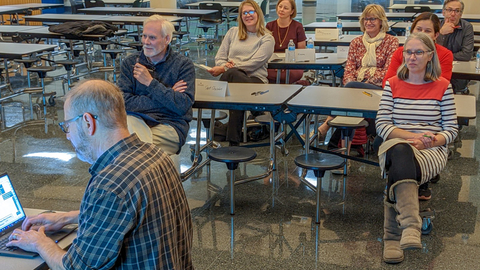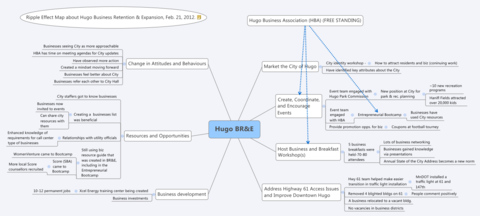Making waves in the world of evaluation
Ripples are tiny waves generated when a stone is dropped into the water. But ripple effect mapping is generating some big waves in the world of evaluation.
Why? Because ripple effect mapping, or REM, is more than an evaluation technique.
How Extension uses REM
Extension uses REM to discover the impacts of community projects or programs. REM sessions combine several evaluation techniques to produce "maps" that tell the story of a program. Of course, these maps don't depict geography but rather the effects of an initiative. And they also do more than inform an evaluation report.
"Ripple effect mapping is a powerful technique to document the impacts of a project or program. But REM also engages and re-energizes community members who need a shot in the arm as they get things done. Conventional evaluation techniques like surveys and focus groups don't do that," says Scott Chazdon, a former evaluation and research specialist with Extension’s Department of Community Development (CD). "It can't replace conventional evaluation techniques, but it's a great addition to the evaluator's toolbox," he notes.
Mix of methods
REM combines four evaluation methods — one-to-one interviews, group interviewing, mind mapping, and qualitative data analysis. It is conducted in five steps:
- Decide whether REM is right for a particular initiative. It's best used to identify outcomes in interventions that have a goal beyond specific individual outcomes.
- Schedule the event and invite participants. The REM process involves community or organization members who participated in a project, as well as sponsors or partners. A group of 12 to 20 participants is ideal.
- Conduct interviews using Appreciative Inquiry questions to start the group conversation. Appreciative Inquiry is a group facilitation method that invites people to reflect on the positive aspects of a project.
At the start of a ripple effect mapping session, participants pair up and interview each other about ways their community was positively affected by a project. These interviews serve as an ice-breaker to prepare participants for the group mapping session.
Hold a group mapping session. The core of a REM session involves group mapping — a process of brainstorming and recording the effects (the "ripples") of a project or program. Groups can use either mind-mapping software or notes taped to a wall.
This process engages the entire group and helps participants see connections among the effects they're describing. Participants also continue building personal relationships). A facilitator and a mapper co-lead the mapping session, which lasts from one to two hours.
The resulting "mind map" visually depicts the effects of an intervention. For example, effects might include greater civic engagement, more public services or new economic activity.Results from a mind mapping session - Clarify, code, and analyze data. After the session, the project leader reorganizes the mind map and collects additional details by interviewing other participants. Data produced in the mapping process can be downloaded into a spreadsheet and coded to represent the various project or program impacts.
For community development programs, we often code things using the Community Capitals Framework.
Benefits of REM
Chazdon cites four benefits of ripple effect mapping:
- It's simple and inexpensive. Mind-mapping software is available for low or no cost, and it's more efficient to gather participants together for one meeting than to conduct individual interviews.
- It captures the impacts of complex work. The technique successfully documents both intended and unintended effects of a project or program. REM lets participants describe the connections they have built, as well as what the connections led to.
- It's motivating and inspiring. Because REM engages both program participants and non-participant stakeholders, it creates positive energy for further local action.
- It's an effective communication tool. The visual nature of ripple maps makes them ideal for sharing project or program impacts with stakeholders like funders or local officials. The depth and specificity of information captured in a ripple map also benefits communications.
Maintain perspective
The benefits of REM are exciting, but Chazdon urges users to maintain perspective. Multiple evaluation methods are usually needed to tell a complete story of a program's effectiveness, he says.
Furthermore, ripple effect mapping is a valuable tool, but "it's up to a community or other group to put the information captured to good use," Chazdon adds. "Evaluators and facilitators can only go so far. It's up to the people involved to keep things going."
Origins of REM
REM was first used between 2007 and 2009 to look at the impact of the Horizons program, an 18-month effort to strengthen leadership and reduce poverty. Extension started conducting REM sessions in 2011 as a way to evaluate community development programs.
As other Minnesota communities and organizations saw how the process works, they asked for help doing it themselves. The Field Guide to Ripple Effects Mapping by Chazdon provides step-by-step guidance for making the process work and also examines the origins of the method.
Learn more
- A Field Guide to Ripple Effects Mapping
- Using Ripple Effect Mapping to Evaluate Program Impact: Choosing or Combining the Methods That Work Best for You
- Ripple effect mapping: A 'radiant' way to capture program impacts
- Ripple effects mapping for evaluation
- Capturing the ripples from community-driven business retention and expansion programs
- Spiraling-up: Mapping community transformation with community capitals framework
For more information about ripple effect mapping in Minnesota, contact an Extension educator.
Reviewed in 2024




